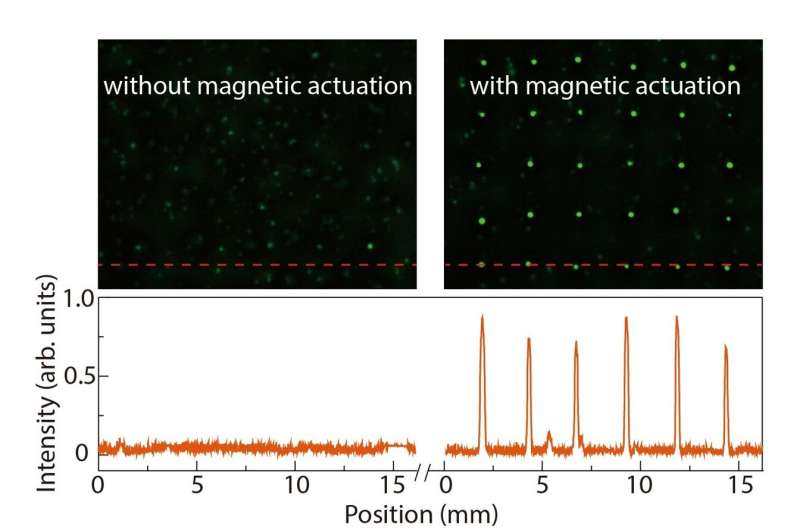Precise manipulation and transportation of micro-sized droplets is a challenging task, yet crucial for biomedical and industrial applications. A research team led by a scholar from the City University of Hong Kong (CityU) has successfully developed a novel droplet manipulation method called “WRAP” which can transport droplets of different sizes and compositions by electromagnets or programmable electromagnetic fields. The research team believes that this innovative method has great potential in developing next-generation microfluidics and in the detection of respiratory droplets bearing COVID-19 and other pathogens landed on the surface.
The research team was led by Dr. Yao Xi, Associate Professor from the Department of Biomedical Sciences (BMS), Jockey Club College of Veterinary Medicine and Life Sciences, at CityU. Their findings were published in the journal Nature Communications.
Flexible and swift transportation of micro-sized droplets on a solid surface with great precision had long been a great challenge to scientists. When compared with other actuation methods based on light, heat, or surface charge, magnetic actuation has many advantages such as rapid response, large driving force and programmable control. However, one of the key issues in the traditional magnetic actuation method is the contamination caused by adding magnetic particles into the droplets, which greatly limits its applications.
“Successful droplet manipulation methods should allow for strong, reversible, and freely programmable droplet actuation while imposing as little restrictions as possible on droplet composition and sizes,” pointed out by Dr. Yao. Aiming at overcoming these challenges, the research team led by Dr. Yao and his collaborators has successfully developed a “magnetic additive-free” wetting ridge assisted programmed (WRAP)magnetic actuation method.
The research team achieved the breakthrough by using ferrofluid. Ferrofluid is a liquid that contains suspended micro, iron particles (ferromagnetic particles) in a solvent. It becomes highly magnetized in the presence of a magnetic field.
Firstly, the team infused ferrofluid into a porous surface. When droplets landed on the porous surface, the ferrofluid automatically “wrapped” the droplets because of the surface tension, and hence formed the magnetically responsive ferrofluid ridges surrounding the droplets due to capillary forces.
When an external electromagnetic field was applied, the ferrofluid ridges were magnetically attracted, moving together with the droplets based on the magnetic field direction. So the transportation path could be controlled programmatically through the design of the external magnetic field.
Dr. Yao explained that the WRAP actuation method was applicable as long as there is a wetting ridge formed. It means that the transportation of droplets is no longer limited by droplet size, surface tension or composition.
In the experiments, the research team used electromagnets to precisely and programmatically control the droplet generation, movement, merging and mixing. “These WRAP based typical applications of droplet manipulation is promising in the development of new digital microfluidics,” said Dr. Yao.

Demonstration of potential of WRAP method in enhancing the sensitivity of biomedical analysis. Without magnetic actuation, some microdroplets randomly coalesce and showed fluorescence signals that were randomly distributed and were barely above noise level (left image). With magnetic actuation, all the microdroplets coalesce to form a lattice pattern, showing strong and regularly distributed fluorescence signals (right image). © Jianqiang Zhang et al.
The team also discovered a great signal enhancement in bioanalysis after the collection and merging of many micro-sized droplets into the big ones by using the WRAP method. As the WRAP method can control the movement of lots of micro-sized respiratory droplets from the patients and merge them into a bigger testing sample, it can potentially facilitate the detection of pathogens such as coronavirus from respiratory droplets landed on a surface by combining with advanced biochemical tests like immunoassays and nucleic acid assays. Dr. Yao believed that in this way, the accuracy (or sensitivity) of the tests can be enhanced.
More information:
Jianqiang Zhang et al, Wetting ridge assisted programmed magnetic actuation of droplets on ferrofluid-infused surface, Nature Communications (2021). DOI: 10.1038/s41467-021-27503-1
Provided by
City University of Hong Kong
Citation:
Scientist invents novel “WRAP” droplet manipulation method (2022, February 11)
